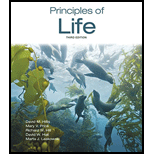
Concept explainers
To draw: A phylogenetic tree of humans, chimpanzees, gorillas, and orangutans and to label the roots and nodes.
Introduction: The complete sequencing of genomes of various organisms has led the biologists to confirm that all of lives are related through a common ancestor. Many model organisms are used to study the gene expression, since organisms share evolutionary relationship. The evolutionary history of these relationship is called as phylogeny.
Answer to Problem 1.1Q
Pictorial representation:

Fig.1: The phylogenetic tree of humans, chimpanzees, gorillas, and orangutans.
Explanation of Solution
The phylogenetic tree is defined as the diagrammatic representation of evolutionary relationship among organisms. The parts of the phylogenetic tree are root, nodes, branches, taxa, and clade. The biological processes that are represented in phylogenetic tree are the evolution of species, population, and genes. The descendants such as humans, chimpanzees, gorillas, and orangutans are derived from the common ancestor, which is denoted as the root. The node is defined as the split in branches that indicates the division of one lineage into two as the result of
Want to see more full solutions like this?
Chapter 14 Solutions
PRINCIPLES OF LIFE
 Human Anatomy & Physiology (11th Edition)BiologyISBN:9780134580999Author:Elaine N. Marieb, Katja N. HoehnPublisher:PEARSON
Human Anatomy & Physiology (11th Edition)BiologyISBN:9780134580999Author:Elaine N. Marieb, Katja N. HoehnPublisher:PEARSON Biology 2eBiologyISBN:9781947172517Author:Matthew Douglas, Jung Choi, Mary Ann ClarkPublisher:OpenStax
Biology 2eBiologyISBN:9781947172517Author:Matthew Douglas, Jung Choi, Mary Ann ClarkPublisher:OpenStax Anatomy & PhysiologyBiologyISBN:9781259398629Author:McKinley, Michael P., O'loughlin, Valerie Dean, Bidle, Theresa StouterPublisher:Mcgraw Hill Education,
Anatomy & PhysiologyBiologyISBN:9781259398629Author:McKinley, Michael P., O'loughlin, Valerie Dean, Bidle, Theresa StouterPublisher:Mcgraw Hill Education, Molecular Biology of the Cell (Sixth Edition)BiologyISBN:9780815344322Author:Bruce Alberts, Alexander D. Johnson, Julian Lewis, David Morgan, Martin Raff, Keith Roberts, Peter WalterPublisher:W. W. Norton & Company
Molecular Biology of the Cell (Sixth Edition)BiologyISBN:9780815344322Author:Bruce Alberts, Alexander D. Johnson, Julian Lewis, David Morgan, Martin Raff, Keith Roberts, Peter WalterPublisher:W. W. Norton & Company Laboratory Manual For Human Anatomy & PhysiologyBiologyISBN:9781260159363Author:Martin, Terry R., Prentice-craver, CynthiaPublisher:McGraw-Hill Publishing Co.
Laboratory Manual For Human Anatomy & PhysiologyBiologyISBN:9781260159363Author:Martin, Terry R., Prentice-craver, CynthiaPublisher:McGraw-Hill Publishing Co. Inquiry Into Life (16th Edition)BiologyISBN:9781260231700Author:Sylvia S. Mader, Michael WindelspechtPublisher:McGraw Hill Education
Inquiry Into Life (16th Edition)BiologyISBN:9781260231700Author:Sylvia S. Mader, Michael WindelspechtPublisher:McGraw Hill Education





